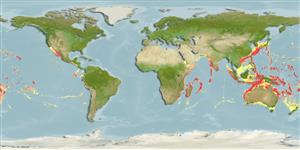Environment: milieu / climate zone / depth range / distribution range
Écologie
marin benthopélagique; profondeur 1 - 1229 m (Ref. 58302). Tropical
Indo-Pacific: in tropical areas.
Taille / Poids / Âge
Maturity: Lm ? range ? - ? cm
Max length : 42.0 cm TL mâle / non sexé; (Ref. 94081); poids max. publié: 663.00 g (Ref. 94081)
Épines dorsales (Total) : 0; Rayons mous dorsaux (Total) : 33 - 36; Épines anales: 0; Rayons mous anaux: 28 - 30. Lateral line complete. Scales of adults without spines.
Usually found near land masses (Ref. 4388).
Life cycle and mating behavior
Maturities | Reproduction | Spawnings | Egg(s) | Fecundities | Larves
Smith, M.M., 1986. Bramidae. p. 633-636. In M.M. Smith and P.C. Heemstra (eds.) Smiths' sea fishes. Springer-Verlag, Berlin. (Ref. 4388)
Statut dans la liste rouge de l'IUCN (Ref. 130435)
Menace pour l'homme
Harmless
Utilisations par l'homme
Pêcheries: intérêt commercial mineur
Outils
Articles particuliers
Télécharger en XML
Sources Internet
Estimates based on models
Preferred temperature (Ref.
123201): 8.1 - 19.6, mean 12.3 °C (based on 506 cells).
Phylogenetic diversity index (Ref.
82804): PD
50 = 0.5039 [Uniqueness, from 0.5 = low to 2.0 = high].
Bayesian length-weight: a=0.02692 (0.01566 - 0.04626), b=2.87 (2.72 - 3.02), in cm total length, based on LWR estimates for this species & (Sub)family-body (Ref.
93245).
Niveau trophique (Ref.
69278): 3.9 ±0.6 se; based on size and trophs of closest relatives
Résilience (Ref.
120179): Milieu, temps minimum de doublement de population : 1,4 à 4,4 années (Preliminary K or Fecundity.).
Fishing Vulnerability (Ref.
59153): Low to moderate vulnerability (32 of 100).
